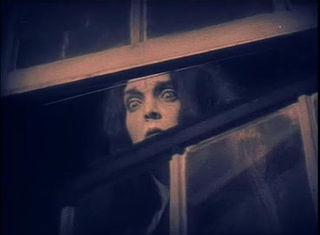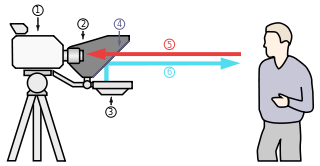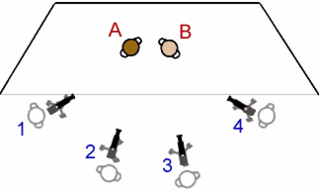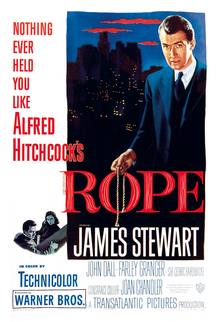Related Research Articles
Feminist film theory is a theoretical film criticism derived from feminist politics and feminist theory influenced by second-wave feminism and brought about around the 1970s in the United States. With the advancements in film throughout the years feminist film theory has developed and changed to analyse the current ways of film and also go back to analyse films past. Feminists have many approaches to cinema analysis, regarding the film elements analyzed and their theoretical underpinnings.

A point of view shot is a film scene—usually a short one—that is shot as if through the eyes of a character. The camera) shows what the subject's eyes would see. It is usually established by being positioned between a shot of a character looking at something, and a shot showing the character's reaction. The POV technique is one of the foundations of film editing.

Shot/reverse shot is a film technique where one character is shown looking at another character, and then the other character is shown looking back at the first character. Since the characters are shown facing in opposite directions, the viewer assumes that they are looking at each other.

Widescreen images are displayed within a set of aspect ratios used in film, television and computer screens. In film, a widescreen film is any film image with a width-to-height aspect ratio greater than 4:3 (12:9).

Rear Window is a 1954 American mystery thriller film directed by Alfred Hitchcock and written by John Michael Hayes based on Cornell Woolrich's 1942 short story "It Had to Be Murder." Originally released by Paramount Pictures, the film stars James Stewart, Grace Kelly, Wendell Corey, Thelma Ritter, and Raymond Burr. It was screened at the 1954 Venice Film Festival.

A teleprompter, also known as an autocue, is a display device that prompts the person speaking with an electronic visual text of a speech or script.

A film transition is a technique used in the post-production process of film editing and video editing by which scenes or shots are combined. Most commonly this is through a normal cut to the next shot. Most films will also include selective use of other transitions, usually to convey a tone or mood, suggest the passage of time, or separate parts of the story. These other transitions may include dissolves, L cuts, fades, match cuts, and wipes.

Compositing is the process or technique of combining visual elements from separate sources into single images, often to create the illusion that all those elements are parts of the same scene. Live-action shooting for compositing is variously called "chroma key", "blue screen", "green screen" and other names. Today, most, though not all, compositing is achieved through digital image manipulation. Pre-digital compositing techniques, however, go back as far as the trick films of Georges Méliès in the late 19th century, and some are still in use.
An axial cut is a type of jump cut, where the camera suddenly moves closer to or further away from its subject, along an invisible line drawn straight between the camera and the subject. While a plain jump cut typically involves a temporal discontinuity, an axial cut is a way of maintaining the illusion of continuity. Axial cuts are used rarely in contemporary cinema, but were fairly common in the cinema of the 1910s and 1920s.
This article contains a list of cinematic techniques that are divided into categories and briefly described.
In film editing, video editing and post production, screen direction is the direction that actors or objects appear to be moving on the screen from the point of view of the camera or audience. A rule of film editing and film grammar is that movement from one edited shot to another must maintain the consistency of screen direction in order to avoid audience confusion.
A script supervisor is a member of a film crew who oversees the continuity of the motion picture including wardrobe, props, set dressing, hair, makeup and the actions of the actors during a scene. The notes recorded by the script supervisor during the shooting of a scene are used to help the editor cut the scene. They are also responsible for keeping track of the film production unit's daily progress. The script supervisor credit is typically in the closing credits of a motion picture. Script supervisors are a department head and play a crucial role in the shooting of a film. It is the script supervisor's job to monitor the camera shots, seeking to maintain coherence between the scenes.
Identification refers to the automatic, subconscious psychological process in which an individual becomes like or closely associates themselves with another person by adopting one or more of the others' perceived personality traits, physical attributes, or some other aspect of their identity. The concept of identification was founded by psychoanalyst Sigmund Freud in the 1920’s, and has since been expanded on and applied in psychology, social studies, media studies, and literary and film criticism. In literature, identification most often refers to the audience identifying with a fictional character, however it can also be employed as a narrative device whereby one character identifies with another character within the text itself.
In film, a match cut is a cut from one shot to another where the composition of the two shots are matched by the action or subject and subject matter. For example, in a duel a shot can go from a long shot on both contestants via a cut to a medium closeup shot of one of the duellists. The cut matches the two shots and is consistent with the logic of the action. This is a standard practice in film-making, to produce a seamless reality-effect.

The multiple-camera setup, multiple-camera mode of production, multi-camera or simply multicam is a method of filmmaking and video production. Several cameras—either film or professional video cameras—are employed on the set and simultaneously record or broadcast a scene. It is often contrasted with a single-camera setup, which uses one camera.

The over-the-shoulder shot is a camera angle used in film and television, where the camera is placed above the back of the shoulder and head of a subject. This shot is most commonly used to present conversational back and forth between two subjects. With the camera placed behind one character, the shot then frames the sequence from the perspective of that character. The over-the-shoulder shot is then utilised in a shot-reverse-shot sequence where both subject's OTS perspectives are edited consecutively to create a back and forth interplay, capturing dialogue and reactions. This inclusion of the back of the shoulder allows audiences to understand the spatial relationships between two subjects, while still being able to capture a closer shot of each subject’s facial expression. In film and television, the filmmaker or cinematographer’s choice of an OTS shot’s camera height, the use of focus and lenses affect the way audiences interpret subjects and their relationships to others and space.

George Tomasini was an American film editor, born in Springfield, Massachusetts, who had a decade long collaboration with director Alfred Hitchcock, editing nine of his movies between 1954 and 1964. Tomasini edited many of Hitchcock's best-known works, such as Rear Window (1954), Vertigo (1958), North by Northwest (1959), Psycho (1960), and The Birds (1963), as well as other well-received films such as Cape Fear (1962). On a 2012 listing of the 75 best edited films of all time, compiled by the Motion Picture Editors Guild based on a survey of its members, four films edited by Tomasini for Hitchcock appear. No other editor appeared more than three times on this listing. The listed films were Psycho, Vertigo, Rear Window, and North by Northwest.

Rope is a 1948 American psychological crime thriller film directed by Alfred Hitchcock, based on the 1929 play of the same name by Patrick Hamilton. The film was adapted by Hume Cronyn with a screenplay by Arthur Laurents.

Last Passenger is a 2013 British suspense thriller film directed by Omid Nooshin. Starring Dougray Scott, Kara Tointon and Iddo Goldberg, this film follows the man; a doctor and a widower, and their commuters' efforts to stop the train after it was discovered to have been hijacked by an unknown, mysterious driver.
This glossary of motion picture terms is a list of definitions of terms and concepts related to motion pictures, filmmaking, cinematography, and the film industry in general.
References
- ↑ Jeremy G Butler (2001). Television: Critical Methods and Applications. Lawrence Erlbaum Associates. ISBN 978-0-8058-4209-8.
- ↑ "Editing guide". Yale University. Retrieved 30 March 2010.
- ↑ "Film lexicon". MIT. Retrieved 30 March 2010.
- ↑ Joseph V. Mascelli (1965). The five C's of cinematography: motion picture filming techniques . Cine Grafi. Retrieved 2012-03-18– via Internet Archive.